2009 INFINITI QX56 sensor
[x] Cancel search: sensorPage 3226 of 4171
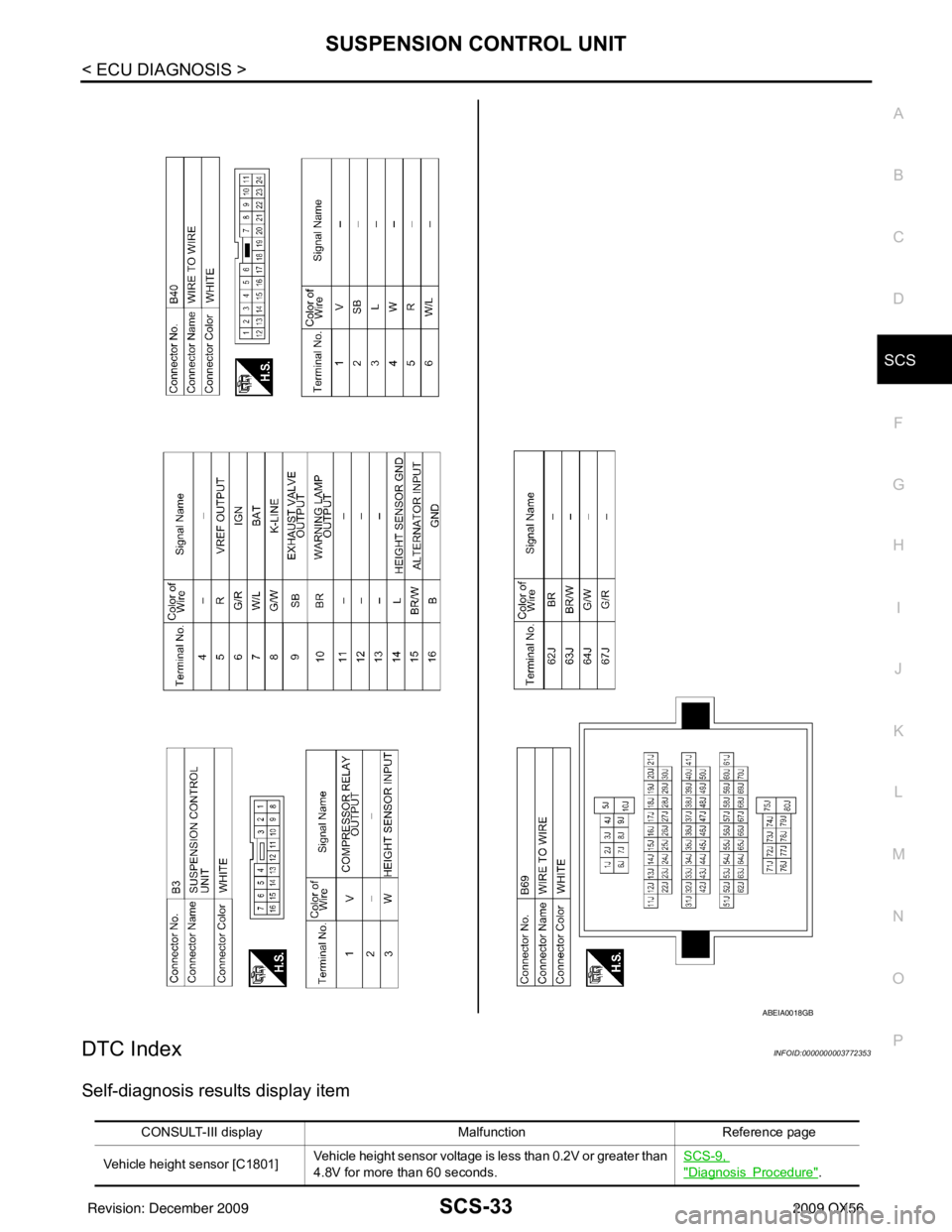
SUSPENSION CONTROL UNITSCS-33
< ECU DIAGNOSIS >
C
DF
G H
I
J
K L
M A
B
SCS
N
O P
DTC IndexINFOID:0000000003772353
Self-diagnosis results display item
ABEIA0018GB
CONSULT-III display MalfunctionReference page
Vehicle height sensor [C1801] Vehicle height sensor voltage is less than 0.2V or greater than
4.8V for more than 60 seconds. SCS-9,
"DiagnosisProcedure".
Revision: December 20092009 QX56
Page 3227 of 4171
![INFINITI QX56 2009 Factory Service Manual SCS-34
< ECU DIAGNOSIS >
SUSPENSION CONTROL UNIT
Compressor relay [C1802]• Driving transistor for compre
ssor relay is OFF and monitor
voltage continues at a high level for more than 10 seconds.
� INFINITI QX56 2009 Factory Service Manual SCS-34
< ECU DIAGNOSIS >
SUSPENSION CONTROL UNIT
Compressor relay [C1802]• Driving transistor for compre
ssor relay is OFF and monitor
voltage continues at a high level for more than 10 seconds.
�](/manual-img/42/57031/w960_57031-3226.png)
SCS-34
< ECU DIAGNOSIS >
SUSPENSION CONTROL UNIT
Compressor relay [C1802]• Driving transistor for compre
ssor relay is OFF and monitor
voltage continues at a high level for more than 10 seconds.
• Driving transistor for compre ssor relay is ON and monitor
voltage continues at a low level for more than 5 seconds. SCS-10, "DiagnosisProcedure".
Exhaust solenoid [C1803] • Driving transistor for exhaust valve solenoid is OFF and
monitor voltage continues at a high level for more than 10
seconds.
• Driving transistor for exhaust valve solenoid is ON and mon- itor voltage continues at a low level for more than 5 seconds. SCS-11,
"DiagnosisProcedure".
Vehicle height adjusting malfunc-
tion (compressor)[C1804] Continuous compressor relay ON time is more than 120 sec-
onds. SCS-12,
"DiagnosisProcedure".
Vehicle height adjusting malfunc-
tion (exhaust solenoid)[C1805] Continuous exhaust valve solenoid ON time is more than 120
seconds. SCS-13,
"DiagnosisProcedure".
Vehicle height sensor locking mal-
function [C1806] Output sensor voltage variation
±0.02V is more than 100 sec-
onds when vehicle height range is normal. SCS-14, "
Diagnosis Proce-
dure".
Sensor 5V malfunction [C1807] Sensor reference voltage is less than 0.8V or more than 6V for
20 seconds. SCS-15,
"DiagnosisProcedure"
Integral time malfunction by sup-
plying air [C1808]A suspension air compressor ON request has been in effect
for 180 seconds and the suspension air compressor has not
activated during that time. SCS-16,
"DiagnosisProcedure".
Revision: December 20092009 QX56
Page 3228 of 4171
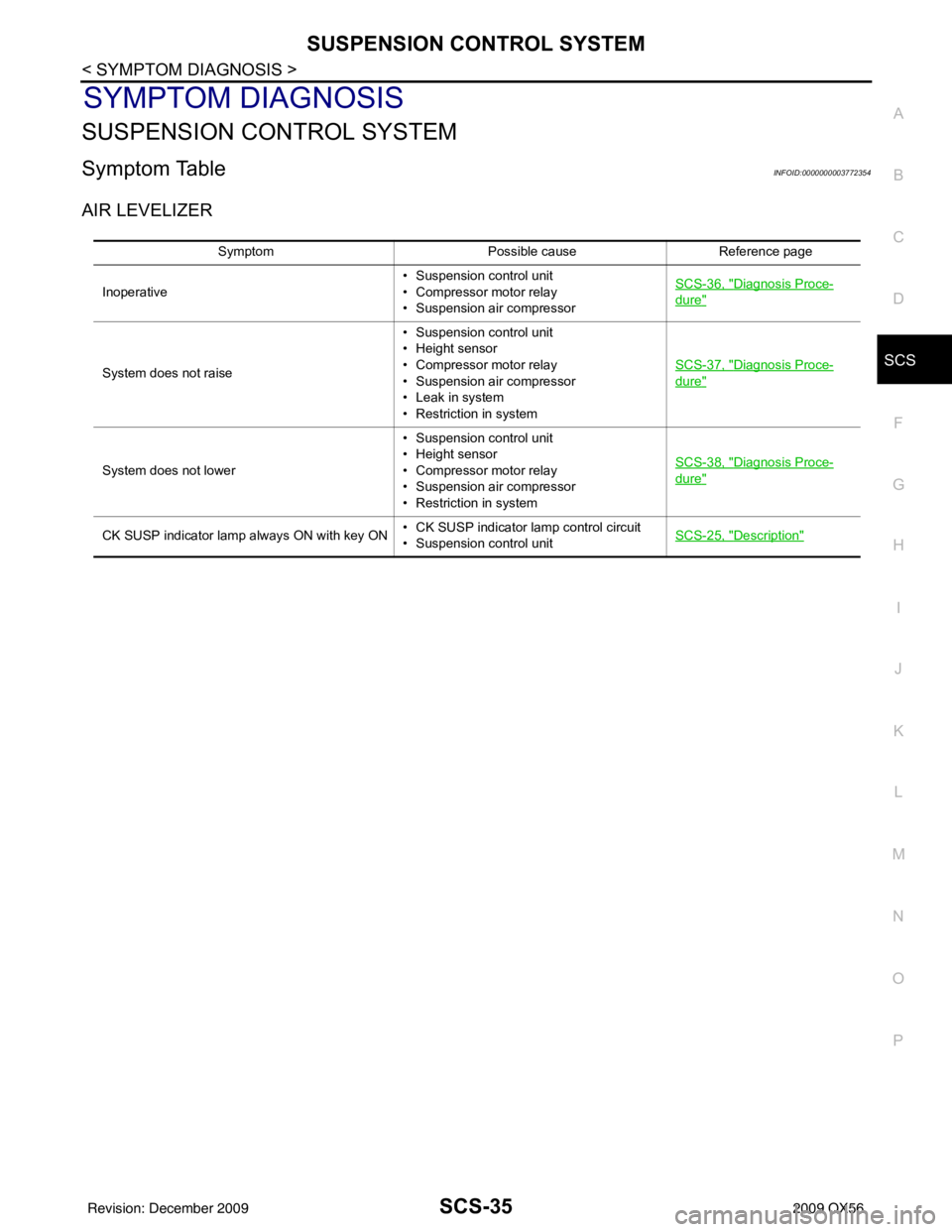
SUSPENSION CONTROL SYSTEMSCS-35
< SYMPTOM DIAGNOSIS >
C
DF
G H
I
J
K L
M A
B
SCS
N
O P
SYMPTOM DIAGNOSIS
SUSPENSION CONTROL SYSTEM
Symptom TableINFOID:0000000003772354
AIR LEVELIZER
Symptom Possible causeReference page
Inoperative • Suspension control unit
• Compressor motor relay
• Suspension air compressorSCS-36, "
Diagnosis Proce-
dure"
System does not raise • Suspension control unit
• Height sensor
• Compressor motor relay
• Suspension air compressor
• Leak in system
• Restriction in systemSCS-37, "Diagnosis Proce-
dure"
System does not lower
• Suspension control unit
• Height sensor
• Compressor motor relay
• Suspension air compressor
• Restriction in systemSCS-38, "Diagnosis Proce-
dure"
CK SUSP indicator lamp always ON with key ON
• CK SUSP indicator lamp control circuit
• Suspension control unitSCS-25, "Description"
Revision: December 20092009 QX56
Page 3229 of 4171
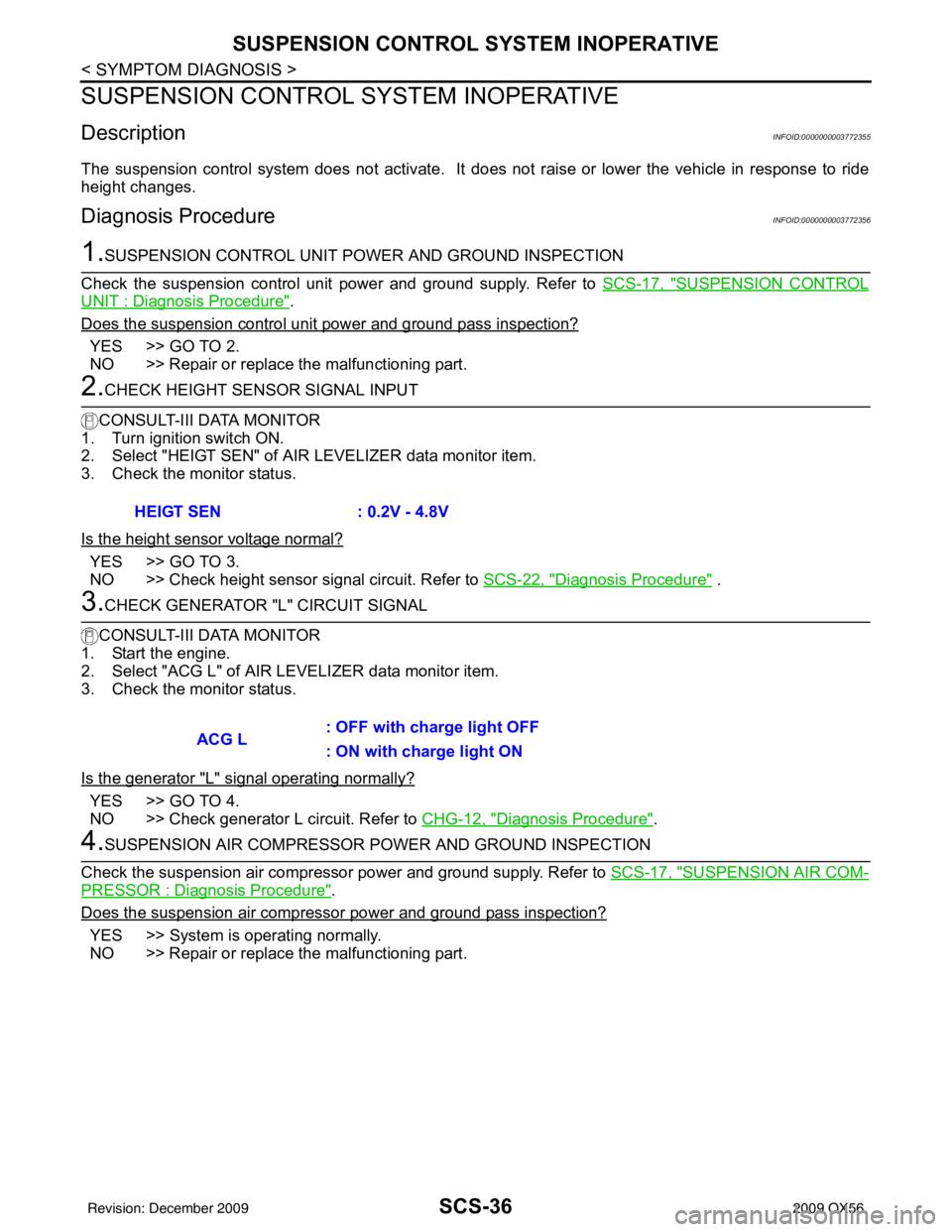
SCS-36
< SYMPTOM DIAGNOSIS >
SUSPENSION CONTROL SYSTEM INOPERATIVE
SUSPENSION CONTROL SYSTEM INOPERATIVE
DescriptionINFOID:0000000003772355
The suspension control system does not activate. It does not raise or lower the vehicle in response to ride
height changes.
Diagnosis ProcedureINFOID:0000000003772356
1.SUSPENSION CONTROL UNIT PO WER AND GROUND INSPECTION
Check the suspension control unit power and ground supply. Refer to SCS-17, "
SUSPENSION CONTROL
UNIT : Diagnosis Procedure".
Does the suspension control unit power and ground pass inspection?
YES >> GO TO 2.
NO >> Repair or replace the malfunctioning part.
2.CHECK HEIGHT SENSOR SIGNAL INPUT
CONSULT-III DATA MONITOR
1. Turn ignition switch ON.
2. Select "HEIGT SEN" of AI R LEVELIZER data monitor item.
3. Check the monitor status.
Is the height sensor voltage normal?
YES >> GO TO 3.
NO >> Check height sensor signal circuit. Refer to SCS-22, "
Diagnosis Procedure" .
3.CHECK GENERATOR "L" CIRCUIT SIGNAL
CONSULT-III DATA MONITOR
1. Start the engine.
2. Select "ACG L" of AIR LE VELIZER data monitor item.
3. Check the monitor status.
Is the generator "L" signal operating normally?
YES >> GO TO 4.
NO >> Check generator L circuit. Refer to CHG-12, "
Diagnosis Procedure".
4.SUSPENSION AIR COMPRESSOR POWER AND GROUND INSPECTION
Check the suspension air compressor power and ground supply. Refer to SCS-17, "
SUSPENSION AIR COM-
PRESSOR : Diagnosis Procedure".
Does the suspension air compressor power and ground pass inspection?
YES >> System is operating normally.
NO >> Repair or replace the malfunctioning part. HEIGT SEN
: 0.2V - 4.8V
ACG L: OFF with charge light OFF
: ON with charge light ON
Revision: December 20092009 QX56
Page 3230 of 4171
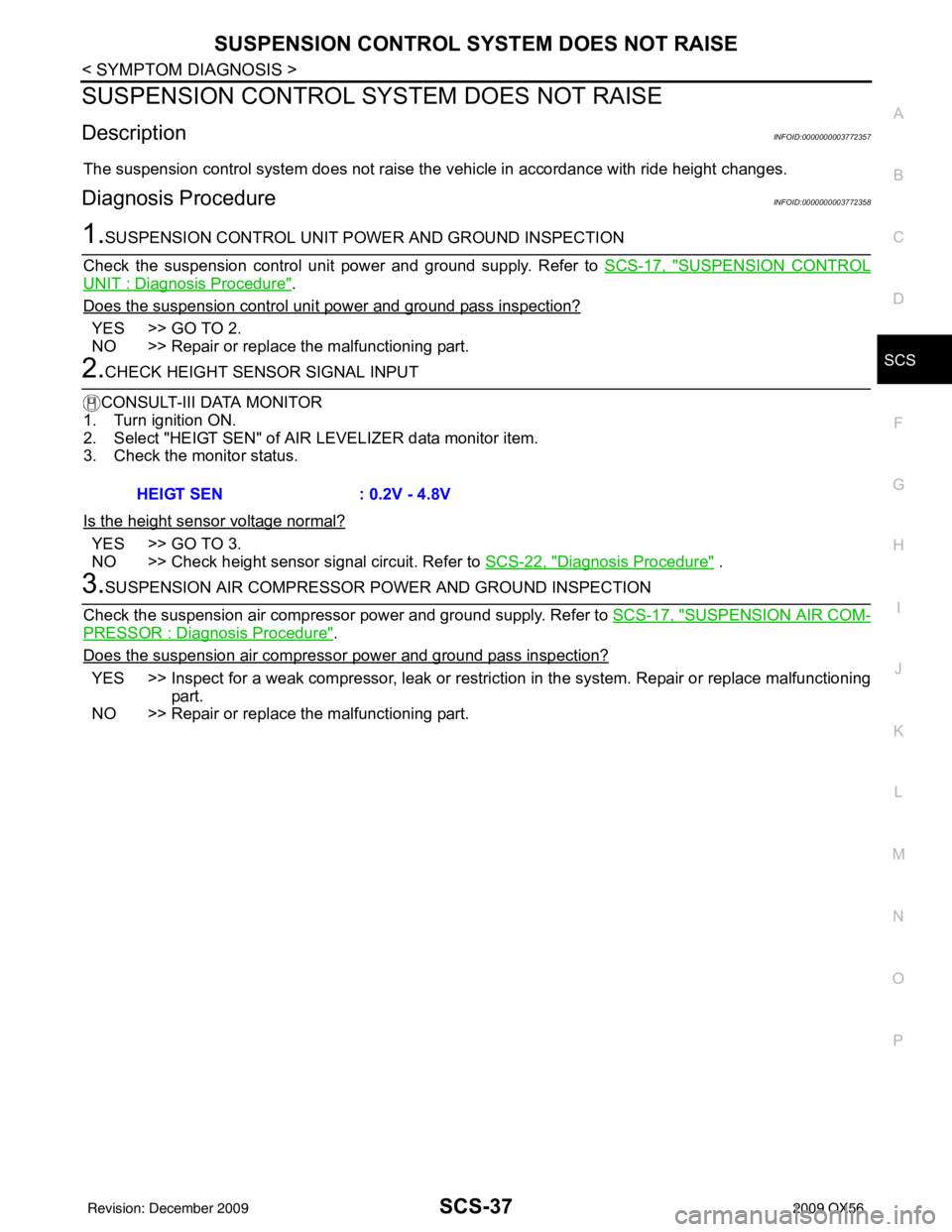
SUSPENSION CONTROL SYSTEM DOES NOT RAISE
SCS-37
< SYMPTOM DIAGNOSIS >
C
D F
G H
I
J
K L
M A
B
SCS
N
O P
SUSPENSION CONTROL SYST EM DOES NOT RAISE
DescriptionINFOID:0000000003772357
The suspension control system does not raise the vehicle in accordance with ride height changes.
Diagnosis ProcedureINFOID:0000000003772358
1.SUSPENSION CONTROL UNIT PO WER AND GROUND INSPECTION
Check the suspension control unit power and ground supply. Refer to SCS-17, "
SUSPENSION CONTROL
UNIT : Diagnosis Procedure".
Does the suspension control uni t power and ground pass inspection?
YES >> GO TO 2.
NO >> Repair or replace the malfunctioning part.
2.CHECK HEIGHT SENSOR SIGNAL INPUT
CONSULT-III DATA MONITOR
1. Turn ignition ON.
2. Select "HEIGT SEN" of AI R LEVELIZER data monitor item.
3. Check the monitor status.
Is the height sensor voltage normal?
YES >> GO TO 3.
NO >> Check height sensor signal circuit. Refer to SCS-22, "
Diagnosis Procedure" .
3.SUSPENSION AIR COMPRESSOR POWER AND GROUND INSPECTION
Check the suspension air compressor power and ground supply. Refer to SCS-17, "
SUSPENSION AIR COM-
PRESSOR : Diagnosis Procedure".
Does the suspension air compress or power and ground pass inspection?
YES >> Inspect for a weak compressor, leak or restriction in the system. Repair or replace malfunctioning
part.
NO >> Repair or replace the malfunctioning part. HEIGT SEN
: 0.2V - 4.8V
Revision: December 20092009 QX56
Page 3231 of 4171
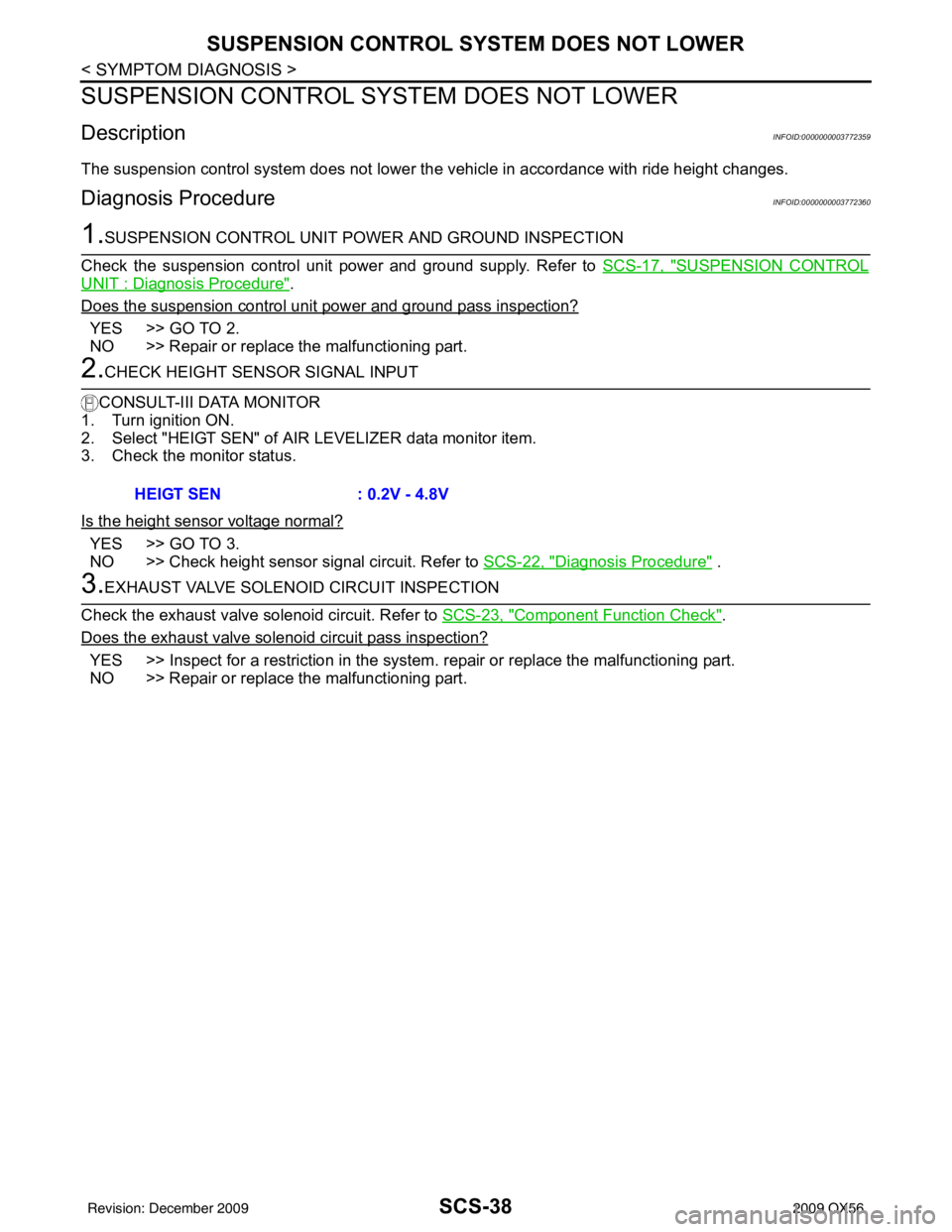
SCS-38
< SYMPTOM DIAGNOSIS >
SUSPENSION CONTROL SYSTEM DOES NOT LOWER
SUSPENSION CONTROL SYSTEM DOES NOT LOWER
DescriptionINFOID:0000000003772359
The suspension control system does not lower the vehicle in accordance with ride height changes.
Diagnosis ProcedureINFOID:0000000003772360
1.SUSPENSION CONTROL UNIT PO WER AND GROUND INSPECTION
Check the suspension control unit power and ground supply. Refer to SCS-17, "
SUSPENSION CONTROL
UNIT : Diagnosis Procedure".
Does the suspension control unit power and ground pass inspection?
YES >> GO TO 2.
NO >> Repair or replace the malfunctioning part.
2.CHECK HEIGHT SENSOR SIGNAL INPUT
CONSULT-III DATA MONITOR
1. Turn ignition ON.
2. Select "HEIGT SEN" of AI R LEVELIZER data monitor item.
3. Check the monitor status.
Is the height sensor voltage normal?
YES >> GO TO 3.
NO >> Check height sensor signal circuit. Refer to SCS-22, "
Diagnosis Procedure" .
3.EXHAUST VALVE SOLENOID CIRCUIT INSPECTION
Check the exhaust valve solenoid circuit. Refer to SCS-23, "
Component Function Check".
Does the exhaust valve solenoid circuit pass inspection?
YES >> Inspect for a restriction in the system . repair or replace the malfunctioning part.
NO >> Repair or replace the malfunctioning part. HEIGT SEN
: 0.2V - 4.8V
Revision: December 20092009 QX56
Page 3232 of 4171
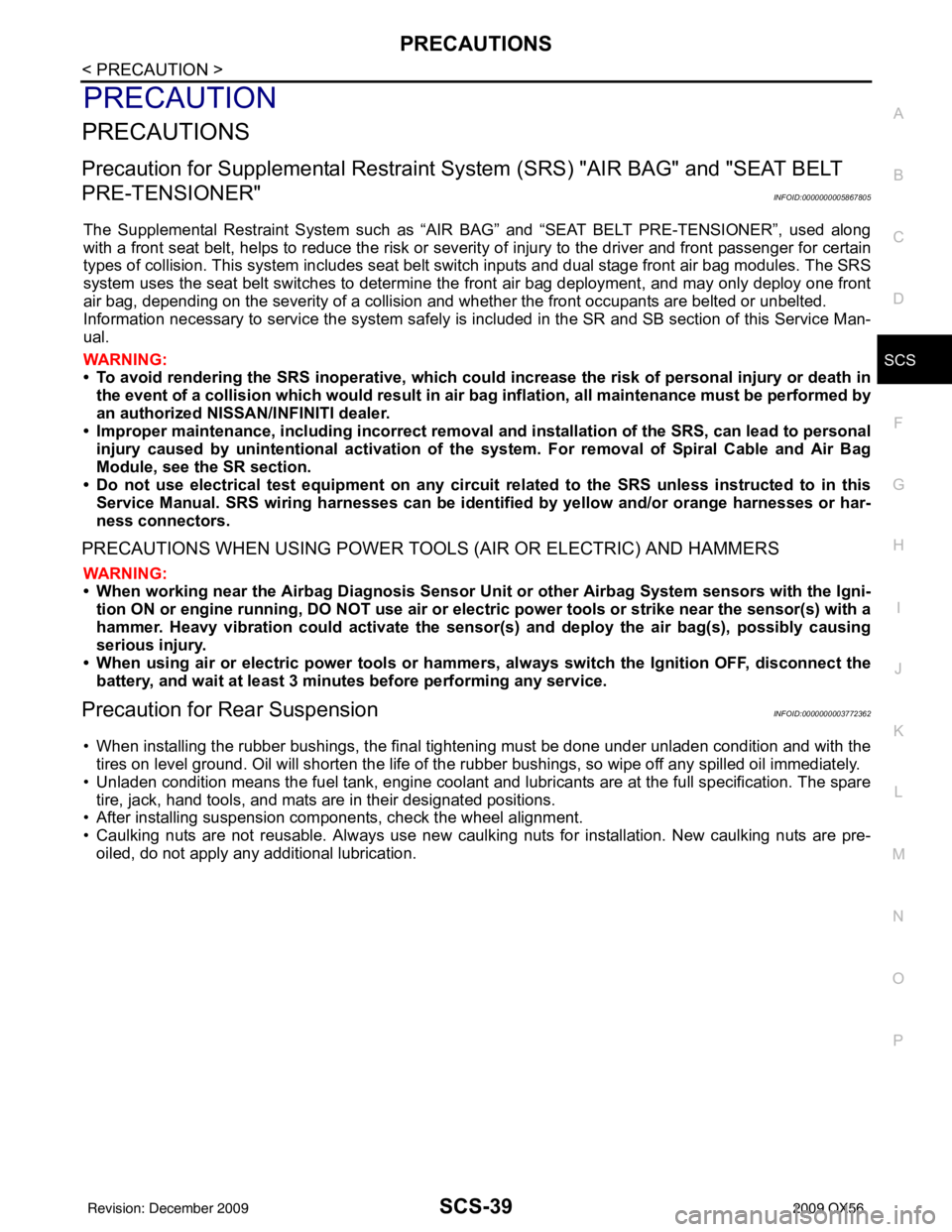
PRECAUTIONSSCS-39
< PRECAUTION >
C
DF
G H
I
J
K L
M A
B
SCS
N
O P
PRECAUTION
PRECAUTIONS
Precaution for Supplemental Restraint System (SRS) "AIR BAG" and "SEAT BELT
PRE-TENSIONER"
INFOID:0000000005867805
The Supplemental Restraint System such as “AIR BAG” and “SEAT BELT PRE-TENSIONER”, used along
with a front seat belt, helps to reduce the risk or severi ty of injury to the driver and front passenger for certain
types of collision. This system includes seat belt switch inputs and dual stage front air bag modules. The SRS
system uses the seat belt switches to determine the front air bag deployment, and may only deploy one front
air bag, depending on the severity of a collision and w hether the front occupants are belted or unbelted.
Information necessary to service the system safely is included in the SR and SB section of this Service Man-
ual.
WARNING:
• To avoid rendering the SRS inoper ative, which could increase the risk of personal injury or death in
the event of a collision which would result in air bag inflation, all maintenance must be performed by
an authorized NISSAN/INFINITI dealer.
• Improper maintenance, including in correct removal and installation of the SRS, can lead to personal
injury caused by unintentional act ivation of the system. For removal of Spiral Cable and Air Bag
Module, see the SR section.
• Do not use electrical test equipm ent on any circuit related to the SRS unless instructed to in this
Service Manual. SRS wiring harnesses can be identi fied by yellow and/or orange harnesses or har-
ness connectors.
PRECAUTIONS WHEN USING POWER TOOLS (AIR OR ELECTRIC) AND HAMMERS
WARNING:
• When working near the Airbag Diagnosis Sensor Un it or other Airbag System sensors with the Igni-
tion ON or engine running, DO NOT use air or el ectric power tools or strike near the sensor(s) with a
hammer. Heavy vibration could activate the sensor( s) and deploy the air bag(s), possibly causing
serious injury.
• When using air or electric power tools or hammers, always switch the Ignition OFF, disconnect the battery, and wait at least 3 minutes before performing any service.
Precaution for Rear SuspensionINFOID:0000000003772362
• When installing the rubber bushings, the final tightening must be done under unladen condition and with thetires on level ground. Oil will shorten the life of the rubber bushings, so wipe off any spilled oil immediately.
• Unladen condition means the fuel tank, engine coolant and lubricants are at the full specification. The spare tire, jack, hand tools, and mats are in their designated positions.
• After installing suspension components, check the wheel alignment.
• Caulking nuts are not reusable. Always use new caulking nuts for installation. New caulking nuts are pre-
oiled, do not apply any additional lubrication.
Revision: December 20092009 QX56
Page 3276 of 4171

SE-44
< PRECAUTION >
PRECAUTIONS
PRECAUTION
PRECAUTIONS
Precaution for Supplemental Restraint System (SRS) "AIR BAG" and "SEAT BELT
PRE-TENSIONER"
INFOID:0000000005880168
The Supplemental Restraint System such as “A IR BAG” and “SEAT BELT PRE-TENSIONER”, used along
with a front seat belt, helps to reduce the risk or severity of injury to the driver and front passenger for certain
types of collision. This system includes seat belt switch inputs and dual stage front air bag modules. The SRS
system uses the seat belt switches to determine the front air bag deployment, and may only deploy one front
air bag, depending on the severity of a collision and w hether the front occupants are belted or unbelted.
Information necessary to service the system safely is included in the SR and SB section of this Service Man-
ual.
WARNING:
• To avoid rendering the SRS inopera tive, which could increase the risk of personal injury or death in
the event of a collision which would result in air bag inflation, all maintenance must be performed by
an authorized NISSAN/INFINITI dealer.
• Improper maintenance, including in correct removal and installation of the SRS, can lead to personal
injury caused by unintent ional activation of the system. For re moval of Spiral Cable and Air Bag
Module, see the SR section.
• Do not use electrical test equipmen t on any circuit related to the SRS unless instructed to in this
Service Manual. SRS wiring harn esses can be identified by yellow and/or orange harnesses or har-
ness connectors.
PRECAUTIONS WHEN USING POWER TOOLS (AIR OR ELECTRIC) AND HAMMERS
WARNING:
• When working near the Airbag Diagnosis Sensor Unit or other Airbag System sensors with the Igni-
tion ON or engine running, DO NOT use air or electri c power tools or strike near the sensor(s) with a
hammer. Heavy vibration could activate the sensor( s) and deploy the air bag(s), possibly causing
serious injury.
• When using air or electric power tools or hammers , always switch the Ignition OFF, disconnect the
battery, and wait at least 3 minu tes before performing any service.
Precaution Necessary for Steering W heel Rotation After Battery Disconnect
INFOID:0000000005889885
NOTE:
• This Procedure is applied only to models with Intelligent Key system and NATS (NISSAN ANTI-THEFT SYS-
TEM).
• Remove and install all control units after disconnecting both battery cables with the ignition knob in the
″LOCK ″ position.
• Always use CONSULT-III to perform self-diagnosis as a part of each function inspection after finishing work.
If DTC is detected, perform trouble diagnosis according to self-diagnostic results.
For models equipped with the Intelligent Key system and NATS, an electrically controlled steering lock mech-
anism is adopted on the key cylinder.
For this reason, if the battery is disconnected or if the battery is discharged, the steering wheel will lock and
steering wheel rotation will become impossible.
If steering wheel rotation is required when battery pow er is interrupted, follow the procedure below before
starting the repair operation.
OPERATION PROCEDURE
1. Connect both battery cables. NOTE:
Supply power using jumper cables if battery is discharged.
2. Use the Intelligent Key or mechanical key to turn the ignition switch to the ″ACC ″ position. At this time, the
steering lock will be released.
3. Disconnect both battery cables. The steering lock will remain released and the steering wheel can be rotated.
4. Perform the necessary repair operation.
Revision: December 20092009 QX56